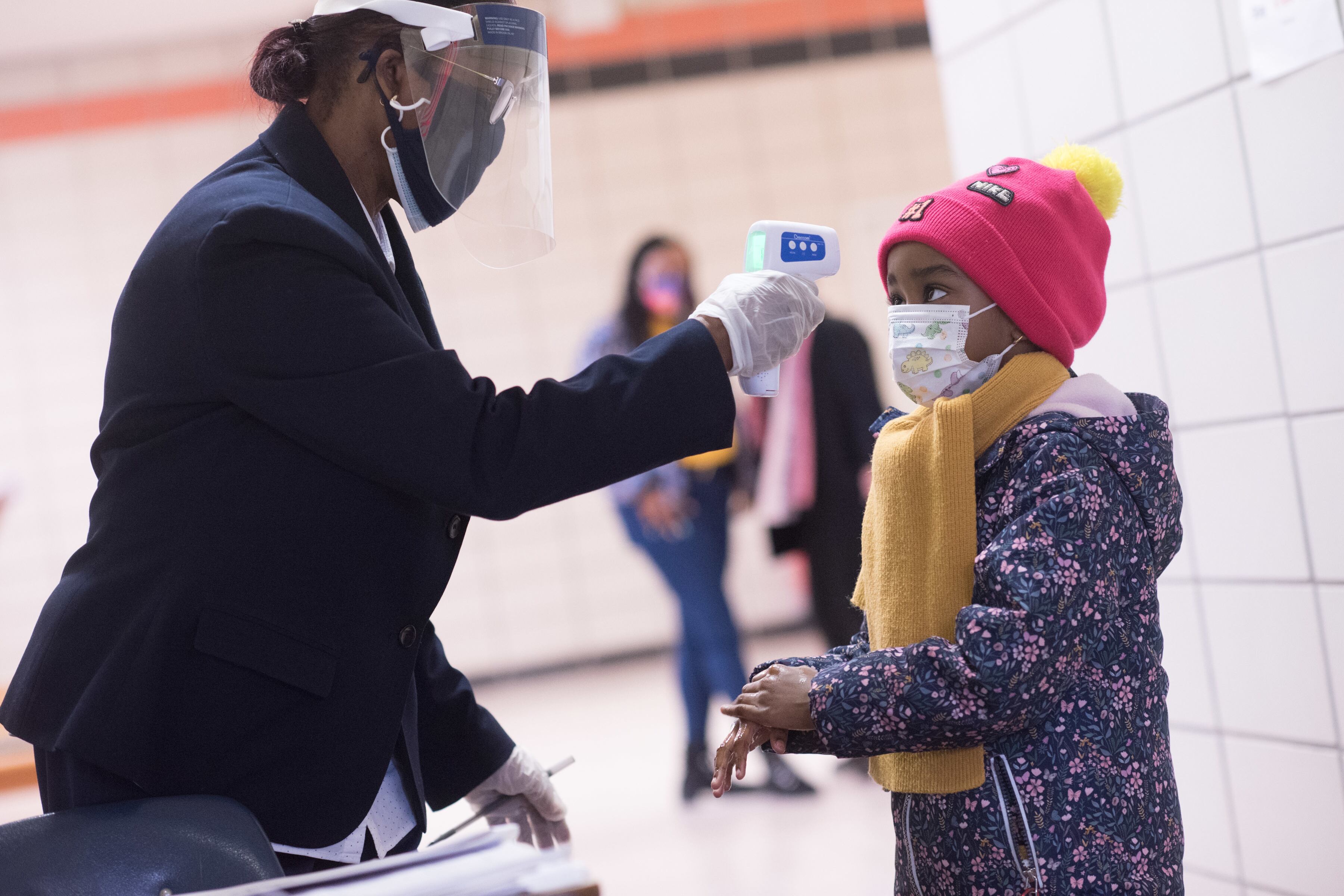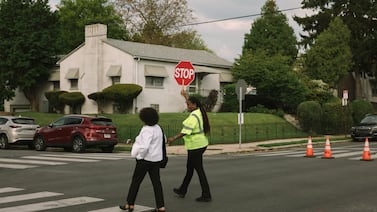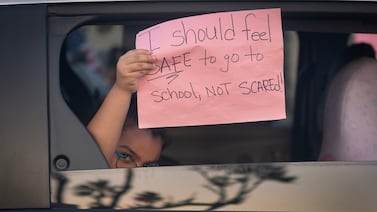With less than three weeks remaining before schools reopen for nearly 1 million students, New York City officials revealed a suite of safety protocols including coronavirus testing and classroom closure policies.
Under the new rules announced Thursday, the city plans to reduce the frequency and scale of random coronavirus testing compared with last year, with 10% of unvaccinated people in schools tested twice a month.
In a few key areas, the city’s policies are stricter than what federal guidance recommends, including on quarantining and masking. When positive cases do pop up, a single case in an elementary school classroom will prompt all students in the room to quarantine and learn remotely, a policy that is more conservative than guidance from the U.S. Centers for Disease Control and Prevention. Vaccinated middle and high school students who are exposed to the virus will not have to quarantine if they don’t show symptoms.
The testing and quarantining rules are key pieces of the reopening puzzle because they determine how often in-person learning could be disrupted and may help to curb the virus’ spread. Last school year, positive coronavirus cases led to thousands of classroom and building closures, resulting in regular ping-ponging between in-person and remote learning at many schools.
Details about instruction during quarantines must still be negotiated with union officials, according to city officials and teachers union president Michael Mulgrew, who said the city’s overall health and safety plan “will keep students and staff safe this year.”
“At the same time the mayor has finally acknowledged the need for virtual instruction for medically fragile children and for those in quarantine,” Mulgrew said in a statement. “We still are working out the details of this remote instruction.”
Unlike last year, when over 60% of students opted to learn fully remotely, all families are expected to send their children to school in person this fall. That has sparked concern among some parents, educators, and elected officials who have called for a remote option as the highly contagious delta variant circulates and questions remain about its impact on children, though serious illness and death remain rare. (Officials announced Thursday that they plan to expand an existing home instruction program for “medically fragile” students with a range of health conditions, though it is expected to serve fewer than 5,000 students.)
Health experts have generally said that vaccines and masking are the two most important protections against the coronavirus spreading in schools. Universal masking in school buildings will be required this year, officials previously announced. And on Monday, Mayor Bill de Blasio said all education department staff will be required to be vaccinated and receive a first dose by Sept. 27 at the latest, two weeks after the first day of school.
Still, with no vaccines currently approved for children 11 years old and younger, and approval possibly months away, most of the city’s students will not be vaccinated when schools reopen. (At least 60% of children ages 12-17 have received at least one dose, officials said earlier this week.)
Here’s what you should know about the safety protocols city officials announced Thursday:
Testing
Schools will continue to require students and staff to complete a daily health screening that confirms they don’t have COVID symptoms or haven’t come in close contact with anyone who has tested positive for the virus.
Once on campus, 10% of unvaccinated people will be tested on a biweekly basis. Fully vaccinated people do not have to participate in testing.
Parents are being asked to consent to the swabs, which can be done through the NYC Schools Account or by downloading a form. A city handbook outlining back-to-school policies says testing will include “individuals who have submitted consent.” Students without consent will not be required to be tested, officials said.
“It is important that you provide consent for your child to participate in the in school testing program,” the city’s handbook says.
Last school year, officials initially required monthly testing of 20% of students and staff then bumped it to a weekly routine in December 2020 after schools were closed amid a rise in COVID cases. Preschool and kindergarten students were previously not included in testing requirements and that will continue this fall.
For summer programs, 10% of students and staff at each site were tested every other week, with a larger portion tested when positive COVID cases pop up.
Justin Lessler, professor of epidemiology at University of North Carolina at Chapel Hill, said this frequency of testing is a good starting point because it’s one part of multiple protective measures, such as masking, social distancing, and ventilation, which his research has shown protects well against virus spread. But as information evolves about COVID and the potential waning of vaccine protection, Lessler said officials should be willing to reconsider the frequency of testing as needed.
“The testing, it seems like, is more intended to be an auxiliary to find infection outbreaks and see if things are sort of falling apart,” Lessler said.
Quarantining
There will be no set number of cases that will cause a school building to be shut down this year. Entire schools will only be closed if city health officials determine that there is “widespread transmission” of COVID inside of the building, including “multiple sources of infection,” officials said.
Entire classrooms will close in elementary schools if someone tests positive, and those children will be required to isolate for 10 days. That policy is more conservative than the CDC recommendation that even unvaccinated students should not have to be quarantined in all cases if they are properly masked and at least three feet away from an infected student and the exposure happened in a classroom.
In middle and high school classrooms, vaccinated students will be allowed to return to school as long as they don’t have symptoms, but city officials are encouraging them to get tested for COVID 3-5 days after exposure to an infected person “out of an abundance of caution.” The CDC goes farther and says vaccinated students should get tested following exposure.
Unvaccinated middle and high school students who are exposed to an infected person will be required to quarantine but can take a COVID-19 test on their fifth day of isolation. If it is negative, they can return to school after their 7th day of quarantine.
City officials acknowledged that the quarantine policy for elementary classrooms is more conservative than what the CDC recommends, and de Blasio also acknowledged it would lead to classroom closures.
“We will have some classroom quarantines, that’s true, but we’re also gonna see a lot of people able to stay when others have to quarantine,” because of vaccinations, the mayor said.
Lessler said this is a reasonable closure policy if the city is trying to balance safety with keeping children in schools. Having zero cases in schools is not possible without wholesale building closures from spring 2020, and “I don’t think anybody is interested in going back there,” Lessler said.
The quarantine rules are a big departure from the highly debated policy last school year, when just two unrelated virus cases caused whole schools to shut down. That policy, which some public health experts called overly conservative, resulted in frequent two-week closures that disrupted stability for students, working caregivers, and teachers. City officials later changed their policy to close buildings only when there are positive cases in four separate classrooms, but still to close individual classrooms with at least one infected person.
“We need to balance all the factors, but we want less disruption this year, while maintaining health and safety,” de Blasio said of schoolwide closures. “It’s going to be much more case by case.”
Instruction when students are in quarantine
Elementary school students will receive live instruction when their classrooms are closed, according to schools Chancellor Meisha Porter. Entire classrooms will have to close for 10 days.
Middle and high school students who are quarantining will have “access” to remote learning, but it’s still unclear how instruction will work if classrooms are split with some students learning remotely and others learning in person (since vaccinated students without any symptoms will continue to attend in person).
Some districts, including Chicago, plan to ask teachers to livestream their classrooms to students at home, but that setup can be challenging for educators to execute, and union leaders in New York City successfully opposed that setup last year.
De Blasio indicated that the city is still negotiating the details of how instruction will be provided with union leaders. “We’re going to be filling in a few more blanks in the next few days because there’s still a couple of issues being worked out,” he said. “We’re still a few weeks out from the beginning of school.”
Virtual instruction for medically fragile students
The education department’s handbook states that medically fragile students may receive instruction through “digital platforms,” which represents a shift in plans.
Previously, the city said it was sticking with its home-bound program for students at risk for complications from the coronavirus, wherein teachers travel to students’ homes to deliver instruction in-person. That was concerning for parents who worried that teachers could expose their children to the coronavirus.
The handbook, however, did not outline how virtual instruction would be delivered, and the teachers union said that was still being negotiated.
Masks
Masks will be universally required in schools, regardless of vaccination status. That includes when staff and students are outdoors, which is stricter than what the CDC recommends. Federal guidance calls for masks outdoors if people are unvaccinated and in crowded settings or when they participate in activities involving “sustained close contact.” Vaccinated people “might choose” to wear a mask in crowded settings and if they live with someone who is immunocompromised, according to the CDC.
The city’s handbook says that there will be designated “mask breaks,” during which students can remove their masks while they “maintain physical distance from each other.” It further adds that students who are not “medically able” to wear masks will be given “alternative accommodations.”
Physical distancing
The CDC has recommended that schools maintain three feet of social distancing — unless doing so prevents students from returning to school full-time. The education department echoes that guidance in their handbook.
That means that some schools will have room to socially distance, while those that struggle with overcrowding likely will not.
The guidance says that elementary schools will make efforts to keep consistent groups of students together “wherever possible.” Parents and students have been particularly worried about lunchtime, when students will be unmasked. The guidance says that schools will use outdoor and other spaces whenever possible, and that meals can be served in multiple locations and across multiple periods.






